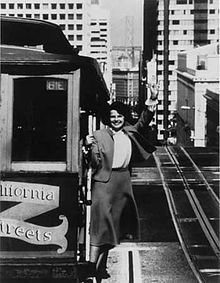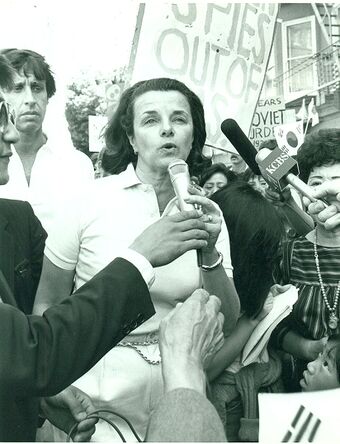Mayor Dianne Feinstein's Failed Housing and Homelessness Policies
Historical Essay
by Randy Shaw, originally published on BeyondChron.org, February 21, 2023
Dianne Feinstein rides a cable car, 1970s.
Photo: Wikimedia Commons
Mayor Feinstein Worsened SF’s Affordability
Senator Dianne Feinstein’s announcement that she would not seek re-election triggered huge media acclaim for her record. The tributes echoed the corporate media’s support of Feinstein while San Francisco’s mayor. I saw no story describing how Feinstein’s policies worsened the city’s affordability. And increased homelessness. And failed to boost housing production.
This history matters. Here’s what should not be forgotten about San Francisco’s Feinstein mayoralty (1979-87).
Misunderstanding Homelessness
From the time widespread visible homelessness began in San Francisco in 1982, Mayor Feinstein insisted the homeless crisis was “temporary.” Year after year of contradictory facts did not change her perception.
Feinstein’s stubborn insistence that homelessness was a short-term crisis led her to implement terrible homeless policies. She actually increased homelessness in the city by refusing to invest in permanent solutions.
Feinstein’s homeless strategy centered on the “hotline hotel” program. San Francisco spent tens to millions of dollars each year converting over 1000 SRO hotel rooms into temporary housing. The unhoused had to line up each day for one-to-three-night stays in hotels that became rundown hovels filled with drug dealing.
I began working in the Tenderloin in 1980 and went fulltime for the Tenderloin Housing Clinic in 1982. I quickly saw how destructive was Feinstein’s program. It harmed both the unhoused and the Tenderloin and Sixth Street neighborhoods. That’s where most hotline hotels were located.
The mayor’s strategy denied permanent housing to the unhoused by converting the SRO hotels they could afford to temporary shelter. San Francisco spent tens of millions each year preventing unhoused welfare and SSI recipients from exiting homelessness.
Feinstein had the city converting SRO rooms to short-term stays that flagrantly violated the city’s 1981 Hotel Conversion Ordinance (HCO). But the weak law (the strongest hotel owner Feinstein would accept) limited enforcement to permanent tenants. Since there were no permanent tenants in these hotels there was nobody left to sue the city.
Dianne Feinstein at rally, 1970s. Future husband Richard Blum behind at left.
Photo: Nancy Wong, via Wikimedia Commons
Despite its failure, and constant public criticism from myself and others, Feinstein’s “hotline hotel” strategy continued throughout her mayoralty.
Had Feinstein accepted that homelessness was not a short-term crisis, she would have invested in permanent housing for the unhoused. San Francisco would today have at least 1000 more additional permanent supportive housing units. Instead, she brought the city no permanent supportive housing units for the unhoused.
Newspapers raved about Feinstein as a caretaker of the city budget. Yet she blew tens of millions of dollars year after year on a failed strategy that did not reduce homelessness by a single person.
The HCO law designed to protect SRO hotels from tourist conversion or demolition was largely unenforceable during her mayoralty.. It wasn’t until Art Agnos was mayor in 1990 that advocates had the political support to strengthen the law. It remains a critical strategy for reducing homelessness and increasing affordability.
David Talbot’s Season of the Witch, likely the most read book about that period of San Francisco, states that “in any other city in America, Dianne Feinstein would have been considered a raving liberal.” Talbot never would have reached that false conclusion if he had talked to his Bernal Heights neighbor, former SF Bay Guardian Editor Tim Redmond. Talbot’s book ignored Feinstein’s disastrous homeless policies. It also completely ignored her opposition to rent control on vacant apartments (discussed below), despite that being the defining issue of San Francisco politics in the 1980’s.
Dianne Feinstein would not have been considered a “raving liberal” in any American city. She was firmly ensconced on the center-right of 1980’s urban politics.
Raising Rents, Worsening Affordability
In addition to increasing homelessness, Mayor Feinstein’s agenda permanently raised rents not just in San Francisco but across California.
San Francisco’s process of extreme gentrification and displacement began in the late 1970’s. Feinstein’s ascension to the mayor’s office brought a landlord and strong ally of Big Real Estate into power at the worst possible time. Feinstein used her power to protect big and small landlords alike; protecting tenants was not part of her world view.
Pressure from tenant groups on supervisors forced Feinstein to sign various measures to strengthen the city’s extremely weak and loophole-filled 1979 rent control law. But she twice vetoed the most important legislation of all: rent control on vacant apartments (aka vacancy control).
A candidate’s position on vacancy control defined San Francisco politics for over a decade. The San Francisco Bay Guardian would not consider endorsing a supervisor candidate opposed to vacancy control.
Because Feinstein twice vetoed vacancy control, the city of San Francisco was not impacted when the Costa-Hawkins bill preempting local vacancy control passed the legislature in 1995. Had Feinstein backed vacancy control it is doubtful Costa-Hawkins, which did not immediately impact any major cities, would have passed.
Some might excuse Feinstein’s vetoes by noting that an Agnos-backed vacancy control measure was overturned in a 1991 referendum. But as I explain in The Activist’s Handbook that was the worst possible election year for San Francisco tenants to face voters. There is no doubt that if San Francisco voters had a chance to limit rent hikes upon vacancies they would do so in a heartbeat.
Without Costa-Hawkins rents would be significantly lower today not just in San Francisco but across California. As I say in my book with that title, fewer Californians would be part of a generation priced out.
Supporting Downzoning
Known as “pro-development” for her support of downtown office towers, Mayor Feinstein balanced her stance by supporting the downzoning of westside neighborhoods. Apartment construction was almost non-existent during her tenure. While the city’s dramatic September 1978 downzoning preceded Feinstein’s mayoralty—it reduced building heights in most areas to under 40 feet—she never used her control of the Board to produce more housing.
Feinstein was far less supportive of increased housing production than mayors Brown, Newsom, Lee and Breed. But the media overlooked her failure on this issue because they saw her as “pro-development.”
The bottom line: Mayor Feinstein laid the groundwork for San Francisco’s longterm unaffordability. In fact, if you had to identify the single San Francisco elected official most responsible for the city’s ongoing high housing prices, it’s Dianne Feinstein.
Photo: Erica Dawn Lyle



